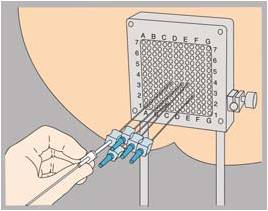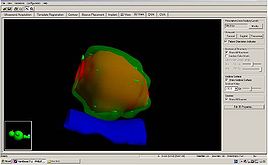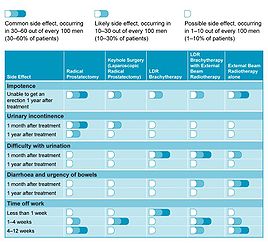
Prostate brachytherapy
Encyclopedia
Brachytherapy
is a type of radiotherapy, or radiation treatment, offered to certain cancer patients. There are two types of brachytherapy – high dose-rate (HDR) and low dose-rate (LDR). LDR brachytherapy is the type that is most commonly used to treat prostate cancer
; it may sometimes be referred to as ‘seed implantation’ or it may also be called ‘pinhole surgery’.
In LDR brachytherapy, tiny radioactive particles the size of a grain of rice (see Figure 1) are implanted directly into the site of the tumour. These particles are known as ‘seeds’, and they can be inserted linked together as strands, or individually. Because the seeds are inserted or implanted directly into, or very close to, the tumour, they deliver high doses of radiation to the tumour without affecting the normal healthy tissues around it. This means that the procedure is less damaging than conventional radiation therapy, where the radioactive beam is delivered from outside the body and must pass through other tissues before reaching the tumour.
LDR prostate brachytherapy (seed implantation) is a proven treatment for early, localised prostate cancer (when the cancer is contained within the prostate). Under a general anaesthetic, the radioactive seeds are injected through fine needles directly into the prostate
, so that the radiotherapy can destroy the cancer cells. The seeds are permanently implanted, so they remain in place but gradually become inactive as the radioactivity decays naturally and safely over time. Unlike traditional surgery, LDR brachytherapy requires no incisions and is normally carried out as a day-case procedure. Sometimes a single overnight stay in hospital is required. Patients usually recover quickly from LDR brachytherapy, which means that most men can return to work or normal daily activities within a few days. As described below, LDR brachytherapy has a good side-effect profile with less risk of incontinence
or impotence than other treatment options, and is becoming an increasingly popular alternative to major surgery (conventional radical prostatectomy or laparoscopic (keyhole surgery) radical prostatectomy).
Isotopes used include iodine 125 and palladium 103.


 When LDR prostate brachytherapy (seed implantation) is carried out, an ultrasound
When LDR prostate brachytherapy (seed implantation) is carried out, an ultrasound
probe is inserted into the back passage (rectum
), and images from this probe are used to assess the size and shape of the prostate gland. This is done so that the doctor can identify how to best deliver the right radiation dose for each patient. Then the seeds are inserted in the exact locations identified at the beginning of the procedure. This usually takes 1–2 hours. No surgical incision is required; instead, the radioactive seeds are inserted into the prostate gland using needles which pass through the skin between the scrotum
and the rectum (the perineum
) and an ultrasound probe is used to accurately guide them to their final position. The needles are put in to the target positions and between 70 and 150 seeds are placed into the prostate. The needles are then removed. Figure 2 shows the grid-like device used to guide the needles into the perineal area; co-ordinates or ‘map references’ on this grid or template are used to pinpoint the exact positions in the prostate where the seeds are to be placed. Figure 3 shows how the seeds are positioned to target the tumour. The doctor uses ultrasound and X-ray pictures to make sure the seeds are in the right place. A special computer software program is used to make sure the prostate gland is completely covered by just the right dose of radiation (see Figure 4) to ensure that all cancer cells present in the prostate have been completely treated.
Once in place, the seeds slowly begin to release their radiation. While the seeds are active, the patient must observe some basic precautions. Travel and contact with adults are fine; however, for the first two months following seed implantation, small children and pregnant women should not be in direct contact with the patient for prolonged periods – for example children should not sit on the patient’s knee for any length of time. Sexual intercourse can start again within a few weeks. Very occasionally a seed can be expelled in the semen on ejaculation; if this does happen, it will usually occur in the first few ejaculations, so it is advisable to use a condom for the first two or three occasions of intercourse following LDR brachytherapy.
Patients can usually get back to normal activities and work within a few days. They should expect to be seen for follow-up after four to six weeks, and then every three months for a year, six-monthly up to five years, then annually.
 LDR prostate brachytherapy (seed implantation) is a very effective treatment for early, localised prostate cancer, with patients rapidly returning to normal activities. Although patients may experience problems (urinary incontinence
LDR prostate brachytherapy (seed implantation) is a very effective treatment for early, localised prostate cancer, with patients rapidly returning to normal activities. Although patients may experience problems (urinary incontinence
or difficulty with urination
) for the first 6 months or so after their implant, these usually settle down and lasting problems are rare, only occurring in about 1–2% of patients. Some patients (less than 10%) report an increase in bowel problems (diarrhoea or urgency of the bowels), but again this usually settles down without further treatment.
Erectile dysfunction
(difficulty getting and/or keeping an erection; impotence) is another side-effect associated with all treatments for prostate cancer. Other treatments for prostate cancer cause problems with erectile dysfunction in 30–60% of men (as seen in Table 1), but these problems are much less common after LDR brachytherapy, and only occur in about 10–30% of men under the age of 60 years, who were potent before treatment.
In a recent study looking at patients’ quality of life, LDR brachytherapy compared favourably with other treatment options. Table 1 summarises the more common side-effects related with each form of treatment and how these may affect patient recovery.
Brachytherapy
Brachytherapy , also known as internal radiotherapy, sealed source radiotherapy, curietherapy or endocurietherapy, is a form of radiotherapy where a radiation source is placed inside or next to the area requiring treatment...
is a type of radiotherapy, or radiation treatment, offered to certain cancer patients. There are two types of brachytherapy – high dose-rate (HDR) and low dose-rate (LDR). LDR brachytherapy is the type that is most commonly used to treat prostate cancer
Prostate cancer
Prostate cancer is a form of cancer that develops in the prostate, a gland in the male reproductive system. Most prostate cancers are slow growing; however, there are cases of aggressive prostate cancers. The cancer cells may metastasize from the prostate to other parts of the body, particularly...
; it may sometimes be referred to as ‘seed implantation’ or it may also be called ‘pinhole surgery’.
In LDR brachytherapy, tiny radioactive particles the size of a grain of rice (see Figure 1) are implanted directly into the site of the tumour. These particles are known as ‘seeds’, and they can be inserted linked together as strands, or individually. Because the seeds are inserted or implanted directly into, or very close to, the tumour, they deliver high doses of radiation to the tumour without affecting the normal healthy tissues around it. This means that the procedure is less damaging than conventional radiation therapy, where the radioactive beam is delivered from outside the body and must pass through other tissues before reaching the tumour.
LDR prostate brachytherapy (seed implantation) is a proven treatment for early, localised prostate cancer (when the cancer is contained within the prostate). Under a general anaesthetic, the radioactive seeds are injected through fine needles directly into the prostate
Prostate
The prostate is a compound tubuloalveolar exocrine gland of the male reproductive system in most mammals....
, so that the radiotherapy can destroy the cancer cells. The seeds are permanently implanted, so they remain in place but gradually become inactive as the radioactivity decays naturally and safely over time. Unlike traditional surgery, LDR brachytherapy requires no incisions and is normally carried out as a day-case procedure. Sometimes a single overnight stay in hospital is required. Patients usually recover quickly from LDR brachytherapy, which means that most men can return to work or normal daily activities within a few days. As described below, LDR brachytherapy has a good side-effect profile with less risk of incontinence
Urinary incontinence
Urinary incontinence is any involuntary leakage of urine. It is a common and distressing problem, which may have a profound impact on quality of life. Urinary incontinence almost always results from an underlying treatable medical condition but is under-reported to medical practitioners...
or impotence than other treatment options, and is becoming an increasingly popular alternative to major surgery (conventional radical prostatectomy or laparoscopic (keyhole surgery) radical prostatectomy).
Isotopes used include iodine 125 and palladium 103.
What does LDR prostate brachytherapy treatment involve?



Ultrasound
Ultrasound is cyclic sound pressure with a frequency greater than the upper limit of human hearing. Ultrasound is thus not separated from "normal" sound based on differences in physical properties, only the fact that humans cannot hear it. Although this limit varies from person to person, it is...
probe is inserted into the back passage (rectum
Rectum
The rectum is the final straight portion of the large intestine in some mammals, and the gut in others, terminating in the anus. The human rectum is about 12 cm long...
), and images from this probe are used to assess the size and shape of the prostate gland. This is done so that the doctor can identify how to best deliver the right radiation dose for each patient. Then the seeds are inserted in the exact locations identified at the beginning of the procedure. This usually takes 1–2 hours. No surgical incision is required; instead, the radioactive seeds are inserted into the prostate gland using needles which pass through the skin between the scrotum
Scrotum
In some male mammals the scrotum is a dual-chambered protuberance of skin and muscle containing the testicles and divided by a septum. It is an extension of the perineum, and is located between the penis and anus. In humans and some other mammals, the base of the scrotum becomes covered with curly...
and the rectum (the perineum
Perineum
In human anatomy, the perineum is a region of the body including the perineal body and surrounding structures...
) and an ultrasound probe is used to accurately guide them to their final position. The needles are put in to the target positions and between 70 and 150 seeds are placed into the prostate. The needles are then removed. Figure 2 shows the grid-like device used to guide the needles into the perineal area; co-ordinates or ‘map references’ on this grid or template are used to pinpoint the exact positions in the prostate where the seeds are to be placed. Figure 3 shows how the seeds are positioned to target the tumour. The doctor uses ultrasound and X-ray pictures to make sure the seeds are in the right place. A special computer software program is used to make sure the prostate gland is completely covered by just the right dose of radiation (see Figure 4) to ensure that all cancer cells present in the prostate have been completely treated.
Once in place, the seeds slowly begin to release their radiation. While the seeds are active, the patient must observe some basic precautions. Travel and contact with adults are fine; however, for the first two months following seed implantation, small children and pregnant women should not be in direct contact with the patient for prolonged periods – for example children should not sit on the patient’s knee for any length of time. Sexual intercourse can start again within a few weeks. Very occasionally a seed can be expelled in the semen on ejaculation; if this does happen, it will usually occur in the first few ejaculations, so it is advisable to use a condom for the first two or three occasions of intercourse following LDR brachytherapy.
Patients can usually get back to normal activities and work within a few days. They should expect to be seen for follow-up after four to six weeks, and then every three months for a year, six-monthly up to five years, then annually.
Indications
LDR prostate brachytherapy (seed implantation) is recommended as a treatment for patients whose cancer is at an early stage (cancer stages T1 to T2), and which has not spread beyond the prostate (localised disease). Doctors use a combination of factors such as cancer stage and grade, PSA level and Gleason score to help them decide if a patient is suitable for LDR brachytherapy. Patients should ask their doctors about the results of these different tests and how they influence the type of treatment they may be offered. LDR brachytherapy in combination with external beam radiotherapy may also be recommended for patients with later-stage cancer and higher PSA level and Gleason score.Risks and benefits
Since its introduction in the mid-1980s, prostate brachytherapy (seed implantation) has become a well-established treatment option for patients with early, localised disease. In the US alone, over 50,000 eligible prostate cancer patients a year are treated using this method. Awareness of this treatment choice has now spread to other parts of the world, and there is widespread and rapidly growing use of the technique. In the UK alone, brachytherapy has been used for over 10 years and thousands of patients have been treated.Clinical benefits
LDR prostate brachytherapy (seed implantation) on its own has been shown to be highly effective for the treatment of early prostate cancer. The rate of survival with no increase in average PSA levels after LDR brachytherapy is similar to that achieved with external beam radiotherapy and radical prostatectomy. However LDR brachytherapy has a lower risk of some of the complications associated with these other treatment options. It is important to remember that many men in this age group die from diseases unrelated to their prostate cancer.Side-effects

Urinary incontinence
Urinary incontinence is any involuntary leakage of urine. It is a common and distressing problem, which may have a profound impact on quality of life. Urinary incontinence almost always results from an underlying treatable medical condition but is under-reported to medical practitioners...
or difficulty with urination
Urination
Urination, also known as micturition, voiding, peeing, weeing, pissing, and more rarely, emiction, is the ejection of urine from the urinary bladder through the urethra to the outside of the body. In healthy humans the process of urination is under voluntary control...
) for the first 6 months or so after their implant, these usually settle down and lasting problems are rare, only occurring in about 1–2% of patients. Some patients (less than 10%) report an increase in bowel problems (diarrhoea or urgency of the bowels), but again this usually settles down without further treatment.
Erectile dysfunction
Erectile dysfunction
Erectile dysfunction is sexual dysfunction characterized by the inability to develop or maintain an erection of the penis during sexual performance....
(difficulty getting and/or keeping an erection; impotence) is another side-effect associated with all treatments for prostate cancer. Other treatments for prostate cancer cause problems with erectile dysfunction in 30–60% of men (as seen in Table 1), but these problems are much less common after LDR brachytherapy, and only occur in about 10–30% of men under the age of 60 years, who were potent before treatment.
In a recent study looking at patients’ quality of life, LDR brachytherapy compared favourably with other treatment options. Table 1 summarises the more common side-effects related with each form of treatment and how these may affect patient recovery.
Summary
In summary, LDR prostate brachytherapy (seed implantation) as a treatment for early, localised prostate cancer is as effective as other recommended treatments, but has fewer serious side-effects. Since it does not involve major surgery, LDR brachytherapy may be preferred by patients because it preserves their quality of life, notably their sex life and urinary control, and limits their time in hospital after the procedure allowing them to return quickly to their everyday lives.External links
- American Brachytherapy Society (USA)
- Canadian Prostate Cancer Network (Canada)
- National Prostate Cancer Coalition (USA)
- Prostate Brachytherapy Advisory Group (UK)
- Prostate Cancer Charity (UK)
- Prostate Cancer Foundation (USA)
- Prostate Cancer Research Institute (USA)
- Prostate UK (UK)
- Vancouver Island Prostate Cancer Research Foundation (Canada)

